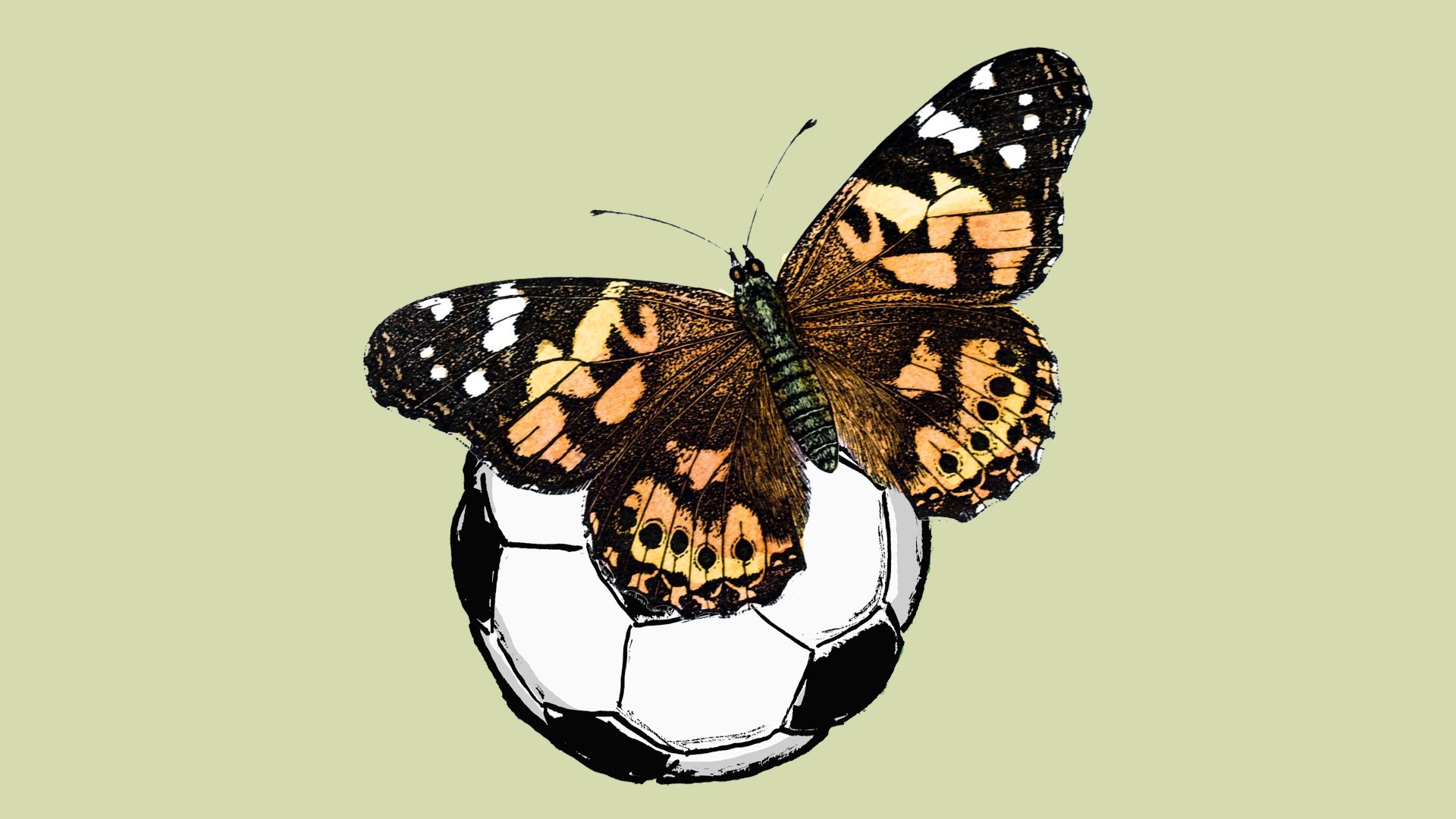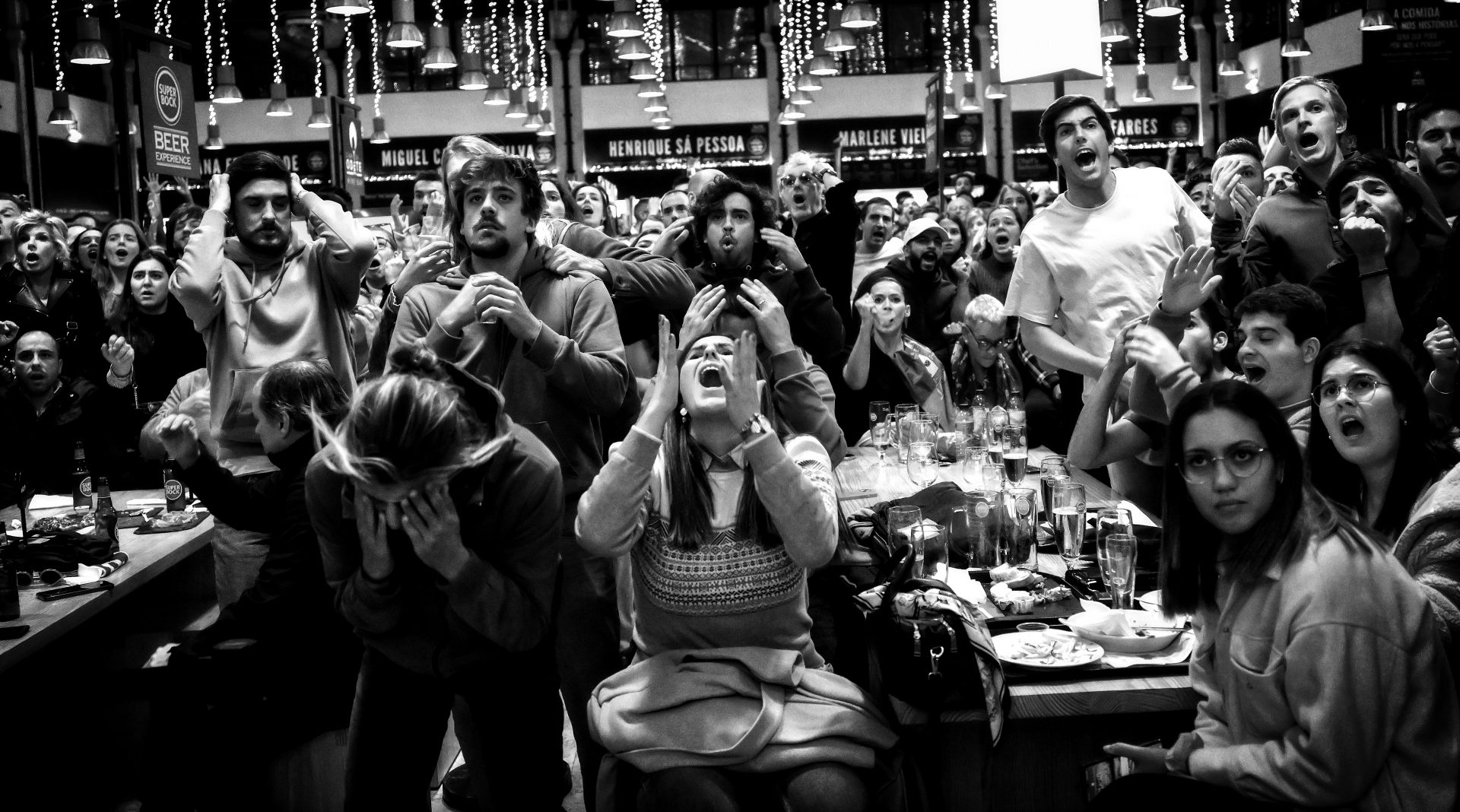Gheorghe Hagi, way out near the left touchline, looked up to see a phalanx of Colombian defenders blocking his path to goal and keeper Óscar Córdoba off his line, further narrowing his options. The Romania midfielder glanced down at the ball and then guided it, with accuracy and venom, over the goalkeeper’s head. As it hit the back of the net Córdoba stood dumbfounded. A worldwide audience of hundreds of millions felt the same.
Hagi’s wonder goal at Pasadena’s Rose Bowl in the 1994 World Cup finals is still talked about today. Out of a period of apparently stable play came a moment of devastating brilliance. It was also a “what if?” moment.
The proverbial butterfly flaps its wings in Sumatra, and three weeks later a tornado ravages Texas. That’s the classic example of chaos theory as defined by American mathematician and meteorologist Edward Lorenz – the notion that tiny events have dramatic effects further down the line. But what if, wondered a group of sports scientists in Cardiff watching Hagi that day, the same kind of thing happened in football? Out of the apparent chaos of a match, are there underlying, often unnoticed, events or patterns that can be identified and exploited to a team’s advantage?
This was back in the 1990s and the project at the University of Wales Institute had only just begun. But with the Fifa men’s World Cup in Qatar looming later this month, does chaos theory – usually more suited to describing the behaviour of weather patterns or dripping taps – offer hope for some of the nations aiming to upset reigning champions France? Has that early work at Cardiff borne fruit?
“There’s no doubt football is a chaotic system,” says Nimai Parmar, senior lecturer in sports performance analysis at the University of Middlesex. “Identifying the patterns underlying that system is the challenge. But today, dynamic systems theory helps explain how we can move from a stable state to an unstable one and the perturbations that cause this.” A stable state might be when a team is in possession of the ball, passing it around, trying to spot an opportunity. Instability is when they seize that moment and create a goalscoring chance.
Dynamic systems theory helps sports scientists to identify such moments. It is an area of mathematics that studies the behaviour of systems that exhibit internal states that evolve over time (such as a football match) and how these systems interact with external inputs (tactics or unexpected passages of play), which are often referred to as perturbations.
Back in 1996 the Cardiff researchers Keith Lyons and Mike Hughes identified perturbations as the key to unlocking the possibilities of chaos theory. “Successful teams exhibit patterns of play,” said Hughes in 1996. “Their actions, such as passing, defending and shooting, show invariance which provide football matches with a pre-ordained course. Yet amid these patterns there are perhaps four or five occasions when the game deviates from this rigid structure.”
Hughes and Lyons believed that if teams could create and exploit those variants or perturbations they were more likely to win. “Today, we can use ball and player tracking to demonstrate the complex relationship that occurs between plays and players,” explains Parmar. “But what is a perturbation? How do we define perturbations and how they create goalscoring opportunities? Sports scientists create frameworks to assess these events.” Chaos theory is one such theoretical framework.
Parmar’s colleague at Middlesex University, Nic James, professor of sport and exercise science and a co-author with Parmar on numerous papers studying the metrics of football matches, explains: “Academics like theoretical frameworks to understand and analyse performance. Sometimes they are useful, sometimes not.
“Of course, we shouldn’t be surprised that any analysis shows that great players create more perturbations in a game,” adds James. “We know Lionel Messi will be good whether we put his ability into a chaos theory framework or not. But analysis using such theoretical frameworks helps us to understand how.”
A contemporary successor to Hagi, Argentinian captain Messi has been the winner of football’s Ballon d’Or – given to the world’s best player each year – seven times. James goes on: “He does things better, yes, but it’s also the unexpected. He does things defences cannot predict.” In effect, the butterfly’s wings are flapping more when Messi has the ball.
“Where the analysis falls down is although we can try to explain why what he does works so well (and possibly coach a defender on how to stop it), what we can’t do with Messi’s brand of unpredictability, for obvious reasons, is foresee what will happen in the future,” adds James. Or, in chaos theory terms, we don’t know when the tornado will strike and where.
James has an example. “England captain Harry Kane is a great penalty-taker, with an 85% success rate. On about 65% of his kicks he puts the ball to the goalkeeper’s right. But obviously, if he did this every time the goalkeeper would know which way to dive. So sometimes he places the ball to the left or down the middle, deliberately breaking his own rhythm.” Essentially Kane is creating his own chaotic system.
But, as James points out: “The challenge is to predict when he will do this. Sports scientists looking to invoke chaos theory perhaps need to try to make attacking players more unpredictable, rather than simply ‘better’,” says James. “But instead of helping attackers, looking for patterns using performance analysis often helps defenders even more. Defenders can learn when perturbations are likely to occur and work to stop them. It’s not just brilliant attackers like Messi who create perturbations, there are defenders whose perturbations stop a goal rather than create one.”
Former Italian defender Paulo Maldini was a prime example. He averaged less than one tackle a match because his positioning on the field was so astute. Players like Maldini often go unnoticed because their success is not defined by a last-ditch tackle, but perhaps created by simply moving to the right part of the field to cut off an attacking route.
Of course, opponents will be watching how teams play, so they too will adopt a different pattern to create a new chaotic system that may supersede the first, showing that a chaos theory framework can influence both the short term of a single match or the longer term of a season or more. “British Cycling gives us a good analogy here,” says James. “They used performance analysis to take advantage of any small benefit they could.”
It was known as marginal gains theory and involved tiny changes (the butterfly wings) such as leaving paint off bikes to reduce weight or rubbing alcohol on the tyres to increase grip, all of which would lead to a cumulative benefit in performance (the tornado). “And it worked,” says James. “Until everybody copied them and then overtook them.” This is a key factor in using chaos theory on a sporting level. Teams must maintain a level of uncertainty in order to keep the perturbations flowing. As Lyons said back in 1996: “If teams don’t keep evolving, they ossify.”
“To stay number one you need to constantly evolve,” agrees James. “Teams like Germany or Brazil do not stagnate. And in other sports you have rugby union’s All Blacks or Australia’s rugby league team constantly developing. If they stagnate, they lose that ability to create perturbations. Teams who refuse to change are easier to stop. That said, some things can stand the test of time, not everything new works.” For example, you don’t change by deciding to run backwards for the entire match. Some rules of thumb are immutable it seems: you don’t give away a corner if you can concede a throw-in and very few teams will create their own negative perturbation by opting to kick the ball very hard towards their own goal. It seems there are boundaries around the instability of chaos.
But can perturbations always be taught, or even identified? Could a player stopping to tie a bootlace, meaning his team-mate chooses to pass to another player instead, lead to a goal 90 seconds later? Is tying the lace the same as the butterfly flapping its wings? “To a certain extent, yes,” says Parmar. “We know goalscoring situations are often preceded by instability.”
“This stuff probably happens frequently,” adds James. “Finding out how much effect such moments have is the challenge. Some are obvious – Steven Gerrard slipping in 2014, allowing Chelsea to score, and gifting the title to Manchester City – others, like the loose bootlace, are more difficult to determine. And then there is the effect of cheating, such as players diving in fake pain to win a penalty or get an opponent sent off. Cheating, unfortunately, causes perturbations and offers benefits.
Yet crucially, not all perturbations come from moments of instability. Hagi’s goal is one example and James cites another. “I have a video that I show students of Gareth Bale playing for Spurs against Southampton in 2013. The match appears to be in a stable phase. I ask them to determine when this situation switches from stable to unstable. Bale gets the ball on halfway, strolls slowly forward. No student is saying ‘now’. The defence looks organised. He strolls some more. Nobody says ‘now’. Then he belts the ball and it flies into the goal. It comes from nowhere. The only unstable thing was the shot. He perturbated the system himself.”
And it’s not just players who create perturbations. Entire teams can do this. In the 1970s, Dutch coach Rinus Michels introduced the concept of total football, first to his club team, Ajax, and then the Netherlands national team. Total football was the concept that any outfield player can occupy the role of any other player in the team; they are not locked into a particular position. It took the Netherlands to the World Cup finals of 1974 and 1978. “When the Dutch evolved total football in the 1970s, they created a chaotic system. Nobody knew how to play against it,” says James.
Further down the line, the concept was developed by Barcelona when Michels and his star player, Johan Cruyff, moved there, leading to their long period of success as it was redefined under new coaches such as Pep Guardiola or, back at Ajax, Erik ten Hag. “Total football makes logical sense,” says James. “But only if your team has players capable of playing it. The Dutch in the 1970s had Cruyff, Ruud Krol and Johan Neeskens, some of the best exponents on the planet.”
Back in 1996, Lyons and Hughes identified Cruyff’s feinted pass and turn against Swedish defender Jan Olsson as the ultimate football perturbation. Olsson was flummoxed, looking the wrong way as Cruyff accelerated past him. Parmar and James agree it was a perfect example, but James also identifies less breathtaking moments, such as the passing of modern-day players like Manchester United’s Bruno Fernandes. “His accuracy means he can take a risk with a long pass, creating a perturbation that leads to a goal,” says James.
But what if your team isn’t up to such high standards? What tactics could one of the less-fancied nations in Qatar, such as Tunisia or Costa Rica, adopt to create their own perturbations against better opposition? “Play to your limits,” advises James. “If you go back to the research of Charles Reep in the 1950s and 60s, he found that most goals are scored after just a few passes. While that work has been somewhat discredited – highly-skilled teams pass far more before scoring – lesser-skilled teams can still utilise the tactic.”
Playing the so-called “long-ball game”, with the ball kicked early into the opposition penalty area, can lead to an unstable situation, with a goal scored from 10 passes or fewer. That long ball or “reacher” bouncing into the penalty area creates many possibilities for perturbations. Of course some might not work in your favour, the defence clears or the ball runs out for a goal kick. But one might. By creating a situation where potentially you move from the stable state into the unstable you can unlock a goalscoring chance. The butterfly’s wings are flapping…
So were the Cardiff researchers ahead of the game? “Yes and no,” says James. “Most of the work sports scientists do has limited effect, we never really discover how much coaches take things on board. And teams obviously won’t admit what works for them because they don’t want the opposition to know. We don’t know 100% how much our work is used and if it is, how successfully. But chaos theory has its place.”
And, as James so pertinently points out: “You can do all the research you want, but when Lionel Messi is on the pitch, it frequently counts for very little.” Chaos and the perturbations it causes might be one thing, football genius is entirely another.




